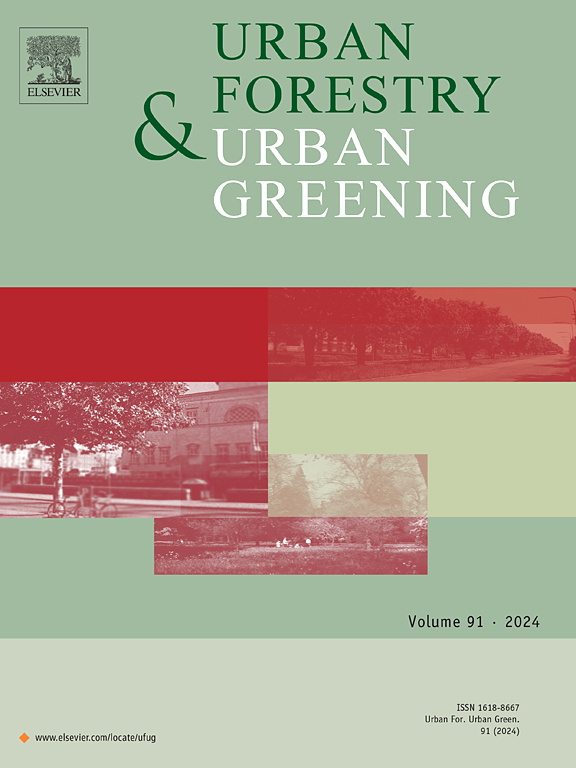Exploring multiscale relationships between environmental characteristics and recreational trail-based activities in urban natural areas: A regional study leveraging user-generated big data and machine learning
IF 6
2区 环境科学与生态学
Q1 ENVIRONMENTAL STUDIES
引用次数: 0
Abstract
Human recreational behaviours in nature represent context- and scale-dependent phenomena. Sustainable urban planning and natural resource management call for effective interventions that target local contexts, which require a refined understanding of human-nature interactions. However, existing studies have failed to concurrently examine multiple spatial scales, nonlinearity and spatial variation in these associations. This study leveraged big data (i.e., Strava sports tracking data for running and cycling) and advanced machine learning techniques (partial dependence plots and geographically weighted random forest) to disentangle the complex relationships between environmental characteristics and recreational activities. Key findings from our study include: (1) the influence of environmental variables on running and cycling varies across perceptual scales, as represented by route-based and survey-based navigation; (2) moreover, specific scales are more appropriate for characterising these relationships; and (3) important variables were identified both at the local level and across the region for running and cycling. Our study proposed multiscale approaches for modelling and understanding the effects of environmental characteristics. The results reinforce the need for context-specific strategies in urban planning. Practical considerations are provided for the planning and design of urban natural areas to promote recreational trail-based activities.
探索城市自然区域环境特征与休闲小径活动之间的多尺度关系:利用用户生成的大数据和机器学习的区域研究
人类在自然界中的娱乐行为表现出依赖于环境和规模的现象。可持续的城市规划和自然资源管理要求针对当地情况采取有效的干预措施,这需要对人与自然的相互作用有精确的了解。然而,现有的研究未能同时考察这些关联的多空间尺度、非线性和空间变异。本研究利用大数据(即Strava运动跟踪数据用于跑步和自行车)和先进的机器学习技术(部分依赖图和地理加权随机森林)来解开环境特征与娱乐活动之间的复杂关系。本研究的主要发现包括:(1)环境变量对跑步和骑行的影响在感知尺度上存在差异,以基于路线和基于调查的导航为代表;(2)具体尺度更适合描述这些关系;(3)在地方层面和跨区域层面确定了跑步和骑行的重要变量。我们的研究提出了多尺度方法来模拟和理解环境特征的影响。研究结果强调了在城市规划中需要有具体情况的战略。为城市自然区的规划和设计提供了实际考虑,以促进休闲径活动。
本文章由计算机程序翻译,如有差异,请以英文原文为准。
求助全文
约1分钟内获得全文
求助全文
来源期刊

Urban Forestry & Urban Greening
FORESTRY-
CiteScore
11.70
自引率
12.50%
发文量
289
审稿时长
70 days
期刊介绍:
Urban Forestry and Urban Greening is a refereed, international journal aimed at presenting high-quality research with urban and peri-urban woody and non-woody vegetation and its use, planning, design, establishment and management as its main topics. Urban Forestry and Urban Greening concentrates on all tree-dominated (as joint together in the urban forest) as well as other green resources in and around urban areas, such as woodlands, public and private urban parks and gardens, urban nature areas, street tree and square plantations, botanical gardens and cemeteries.
The journal welcomes basic and applied research papers, as well as review papers and short communications. Contributions should focus on one or more of the following aspects:
-Form and functions of urban forests and other vegetation, including aspects of urban ecology.
-Policy-making, planning and design related to urban forests and other vegetation.
-Selection and establishment of tree resources and other vegetation for urban environments.
-Management of urban forests and other vegetation.
Original contributions of a high academic standard are invited from a wide range of disciplines and fields, including forestry, biology, horticulture, arboriculture, landscape ecology, pathology, soil science, hydrology, landscape architecture, landscape planning, urban planning and design, economics, sociology, environmental psychology, public health, and education.
 求助内容:
求助内容: 应助结果提醒方式:
应助结果提醒方式:


